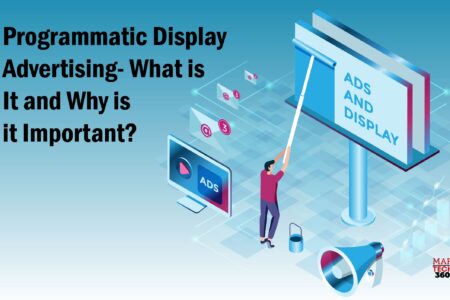Programmatic display advertising has been a buzzword in the marketing industry for quite some time. To grasp the meaning of the term, let’s start by recognizing that within programmatic advertising, there are various methods to connect with your target audience.
Programmatic display advertising focuses on a particular format – the display ad. It’s essential to highlight this distinction when discussing programmatic display.
This post aims to guide you through understanding the term’s significance and workings.
What Is Programmatic Display Advertising?
Programmatic display advertising automates the buying and selling of display ads using software and algorithms. It targets specific audiences, optimizes ad placements, and makes real-time bidding decisions. This approach enables advertisers to reach their target audience more effectively and efficiently through data-driven insights and automation. Unlike traditional display advertising, which relies on manual negotiations and individual ad placements, programmatic display ad offers greater precision, scalability, and cost-effectiveness in ad campaigns.
How Does Programmatic Display Advertising Work?

- Data Collection: Data is gathered from various sources, like user behavior and demographics.
- Audience Targeting: Advertisers define their target audience based on criteria such as age, location, and interests.
- Real-Time Bidding (RTB): Advertisers bid for ad impressions in real-time auctions.
- Ad Placement: The winning ad is placed on websites or mobile apps matching the target audience.
- Ad Creative: The ad, including images and text, is delivered to the chosen placement in real-time.
- Ad Performance Optimization: Platforms adjust bids and targeting to optimize campaign performance.
- Reporting and Analytics: Advertisers receive detailed reports on ad performance, including impressions, clicks, and ROI.
There are two main types of programmatic display advertising: Programmatic Real-Time Bidding (RTB) and Programmatic Direct.
- Programmatic RTB: This method operates similarly to bidding systems like AdWords. When a webpage with a programmatic ad space loads, data about the webpage and user is sent to the ad exchange or SSP. The ad exchange then awards the ad space to the highest bidder in milliseconds. Advertisers use Demand-Side Platforms (DSPs) to automatically bid on relevant ad spaces based on their criteria.
- Programmatic Direct: Also known as automated guaranteed, this approach allows advertisers to purchase ad space programmatically without bidding. Advertisers can secure ad space for a specified period or number of impressions without the need for real-time bidding. This method offers guaranteed ad placement, providing better targeting options such as serving ads to visitors from specific zip codes.
According to eMarketer, $27 billion was spent on programmatic direct, representing 58% of all programmatic advertising. This method is particularly beneficial for advertisers seeking precise targeting capabilities, allowing them to control when and where their ads are displayed.
Understanding Display Advertising in Digital Marketing
Display advertising is prevalent in the realm of digital marketing, constituting the majority of ads seen on the internet. These ads encompass a wide array of media formats, including text, video, gifs, audio, static images, HTML5, and flash content.
The primary purpose of display ads is to capture the attention of the target audience and are commonly employed in brand retargeting, brand awareness, or acquisition campaigns.
When discussing programmatic display advertising, there’s a distinction made between programmatic banner ads and display ads traded outside of automation software.
Also Read: Why Every Company Needs Powerful Brand Storytelling [Tips Included]
Why is Programmatic Display Ad Important?
- Efficiency: By automating the ad buying process, programmatic advertising saves time and resources compared to traditional manual methods. It streamlines campaign management, targeting, and optimization, allowing advertisers to reach their desired audience more efficiently.
- Targeting Precision: Leveraging data and advanced targeting capabilities, programmatic advertising enables advertisers to reach specific audiences based on demographics, interests, browsing behavior, and more. This precision targeting increases the likelihood of delivering relevant ads to the right people at the right time.
- Real-Time Optimization: Programmatic platforms continuously analyze campaign performance and make real-time adjustments to optimize ad delivery. This includes adjusting bids, targeting parameters, and creative elements to maximize campaign effectiveness and return on investment.
- Scale and Reach: Programmatic advertising provides access to a vast inventory of ad placements across multiple websites, apps, and platforms. It allows advertisers to reach a larger audience and expand their brand’s visibility.
- Data-Driven Insights: Programmatic advertising generates valuable data and insights on ad performance, audience behavior, and campaign effectiveness. This data can be used to refine targeting strategies, optimize creative elements, and make informed decisions for future campaigns.
- Cost-Effectiveness: By setting budgets, controlling spending, and optimizing bids based on performance data, programmatic advertising helps maximize the efficiency of ad spend and achieve better ROI compared to traditional advertising methods.
Final Takeaway
Programmatic display advertising has revolutionized the buying and selling of ads, offering efficiency, precision targeting, real-time optimization, and valuable data-driven insights. It automates the ad buying process, enabling advertisers to reach their target audience more effectively. This tool optimizes campaigns, maximizes return on investment, and enhances marketing effectiveness. As technology evolves, these advertising will likely play a more significant role in reaching and engaging audiences.

